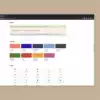From months to days: how we cut Flexmail’s onboarding time
Flexmail helps companies run GDPR-compliant email campaigns, surveys, and forms. The product is powerful, but over the years, it had become complex.
Twelve years of engineering-led decisions had added layer after layer of configuration. That made it harder for new users to get started, and meant the Flexmail team spent too much time explaining how the platform worked instead of closing deals.
They came to us with a clear ask: help us shorten the path from demo to first value.
How we helped
-
We redesigned the contact system from the ground up
The old structure made it hard to know where your data lived. So we created one central contact database that was easy to upload to, browse, and edit. All in one place. It reduced friction and made segmentation clearer. -
We tested the new flow with real users
We ran real onboarding scenarios with potential and existing users. Could they find their contacts? Could they segment lists easily? Even with just five testers, we spotted recurring issues that we could fix fast. -
We supported a smooth rollout
Introducing a new way of working takes care. We worked with the dev team to ensure the new experience worked for both new users and long-time customers, and didn’t break existing workflows.


What changed (and why it matters)
-
From weeks to days
New clients now get up and running in a few days, without needing a demo. -
Sales team freed up
With onboarding largely self-serve, they can focus on closing — not chasing. -
Handed over, not left hanging
We helped Flexmail hire a junior product manager and trained their in-house designers to keep improving the product.
Smooth Sailing rocks at challenging existing concepts but they are conscious enough to stay true to the nature of your product.